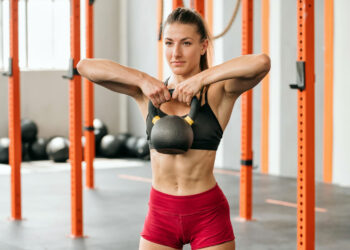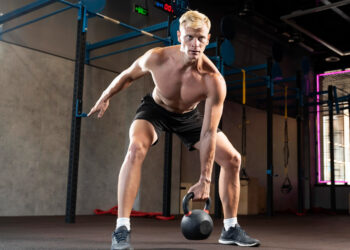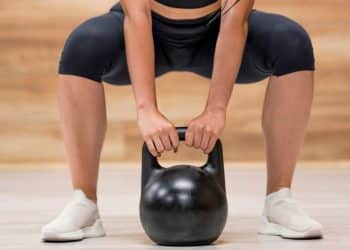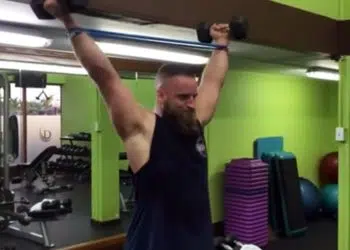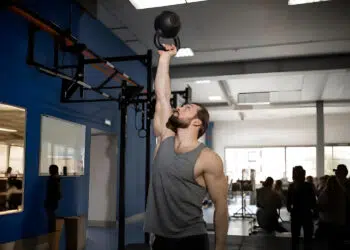I’m a long-time fan of kettlebell training. In fact, I was using them for ten years before CrossFit began popularizing them. That’s because I’ve been working in the fitness industry for over 30 years and have experimented with almost every type of strength training equipment ever made.
You see, kettlebells are not new. In fact, they’re been around for several centuries (1). I first read about them in an old Joe Weider bodybuilding magazine. So, I saved up my money and bought one. I’ve still got that original kettlebell. It’s rusty and chipped but still functional.
There are lots of exercises you can do with a kettlebell, which is part of their appeal; they’re incredibly versatile. However, one of my favorite kettlebell movements is the good morning. This is an excellent alternative to the more common barbell good morning, which many people find awkward.
In this guide, I explain how and why to do kettlebell good mornings and share three of the best variations.
Kettlebell Good Mornings Correct Form & Execution
How you do an exercise is as important as the much weight you lift, or the number of sets and reps you perform. In short, good technique is always safer and more effective than poor technique. Follow these steps to ensure you’re doing kettlebell good mornings correctly.
- Hold your kettlebell in front of your chest, so the handle is just below your chin. Pull your shoulders back and down, and brace your core.
- Stand with your feet hip to shoulder-width apart, knees slightly bent.
- Hinging from your hips, push your butt back and lean forward as far as your flexibility allows. Do not round your lower back.
- Drive your hips forward and stand up.
- Reset your core and grip, and repeat.
Muscles Worked
The kettlebell good morning is a compound exercise, meaning it involves multiple joints and muscles working together. The main muscles trained by kettlebell good mornings are:
Level Up Your Fitness: Join our 💪 strong community in Fitness Volt Newsletter. Get daily inspiration, expert-backed workouts, nutrition tips, the latest in strength sports, and the support you need to reach your goals. Subscribe for free!
- Gluteus maximus
- Hamstrings
- Erector spinae
- Core
In addition, holding the weight as you lean forward means you’ll also need to use your biceps, upper back, and shoulders during this exercise. However, these muscles are secondary to those of your lower body.
Pro-Trainer Tips
Get more from kettlebell good mornings with these tried-and-tested pro-trainer tips.
- Don’t use very heavy weights. It’s almost impossible to hold a heavy kettlebell in the correct position for good mornings. Light to moderate weights work best.
- Keep your chest up and shoulders back to maintain optimal posture and increase glute and hamstring engagement.
- Clench your glutes between reps to maximize muscle recruitment.
- Use gym chalk to stop your hands from slipping.
- Wear flat shoes or go barefoot to keep your weight on your heels to make your hamstrings work harder.
Kettlebell Good Morning Mistakes to Avoid
Make kettlebell good mornings as safe as possible by avoiding these common mistakes.
- Rounding your lower back. This puts a lot of stress on your intervertebral disks and ligaments and can cause severe injuries. Keep your lower back slightly arched.
- “Dive-bombing” your reps. Descend slowly and under control. Going too fast takes tension away from the target muscles and increases your risk of injury.
- Going too heavy, too soon. Use light to moderate weights and perfect your technique before progressing to heavier kettlebells.
- Not keeping your core braced. Tense your abs and keep them tense throughout your workout. This helps stabilize your spine and lowers your risk of injury.
- Doing kettlebell good mornings too often. Make sure you leave yourself a couple of days between workouts for rest and recovery.
Kettlebell Good Morning Benefits
Not sure if kettlebell good mornings deserve a place in your workouts? Consider these benefits and then decide.
- A stronger posterior chain: Posterior chain is the collective term for the muscles on the back of your body, especially the glutes, hamstrings, and lower back. These muscles are critical for lifting, running, and jumping activities, and can help reduce the risk of chronic back pain (2). Kettlebell good mornings are a safe and accessible way to train these critical muscles.
- An accessible exercise: Kettlebells are widely available and found in most gyms. Home exercisers can easily purchase or make them, too. As such, this is a very accessible exercise that most people can do, whether they train in a commercial gym or in their garage.
- The weight is easy to control: Conventional good mornings are done using a barbell. Invariably, barbells are long, heavy, and awkward to handle. This is especially true for beginners. With kettlebell good mornings, the weight is much more compact and easier to control. Consequently, this exercise is more manageable for less experienced exercisers.
- Increased comfort: You do barbell good mornings with the weight resting on your upper back. Some exercisers find this uncomfortable, especially as they lean forward and the weight moves upward. There is no such issue when you do good mornings with a kettlebell.
- More upper-body engagement: While good mornings are most definitely a lower body exercise, using a kettlebell means your arms, back, and shoulders also get a good workout. You’ll have to engage these muscles to control the weight. Subsequently, this increases the number of calories you burn, as well as your heart and breathing rate, which may be beneficial for some exercisers.
Kettlebell Good Morning Programming
Kettlebell good mornings work best when done with light to moderate weights for medium to high reps. 2-4 sets of 8-12 reps work well, but you can go as high as 20-30 reps if you prefer to train with very low weights. Gradually increase your weight or reps as you get stronger. However, never sacrifice good form for more weight.
This exercise is not well suited to heavy weights and low reps. As such, it is not suitable for pure strength-building workouts.
Do kettlebell good mornings 1-3 times per week, but avoid doing them on consecutive days, as this could lead to overtraining.
Level Up Your Fitness: Join our 💪 strong community in Fitness Volt Newsletter. Get daily inspiration, expert-backed workouts, nutrition tips, the latest in strength sports, and the support you need to reach your goals. Subscribe for free!
Kettlebell Good Morning Variations
Kettlebell good mornings are an effective and popular exercise. That said, there are several other ways you can perform this movement. Here are my three favorite kettlebell good morning variations.
1. Behind the neck kettlebell good mornings
Do you want to do conventional good mornings but use a kettlebell instead of a barbell? Then this is the exercise for you. Holding the kettlebell behind your neck means you won’t have to support so much weight with your arms. Also, the lever length is longer, so you’ll have to work a little harder to stabilize your spine. This variation is a good option for more experienced exercisers.
2. B-stance kettlebell good mornings
B-stance or staggered stance kettlebell good mornings emphasize one side of your body at a time. This is useful for identifying and fixing left-to-right strength imbalances. However, unlike single-leg good mornings, balance is not an issue, as you use your non-working leg for support.
3. Single-leg kettlebell good mornings
https://youtu.be//xM-M6v6fLmk?si=M3SUkqH_yup_LuZt
Many of life’s most strenuous activities happen unilaterally or on one leg. Examples include running, jumping, kicking, and lifting. Most sports also involve unilateral movements. As such, bilateral or two-legged exercises don’t always transfer well to life outside the gym.
Single-leg kettlebell good mornings are arguably more functional than the two-legged version and will also enhance your balance. Whether you are an athlete or just want to be better prepared for the demands of active living, this variation is a good choice.
Kettlebell Good Mornings – Closing Thoughts
Good mornings are a controversial exercise. Some trainers believe they’re dangerous and should be avoided at all costs. I’m not one of them! In fact, done correctly, the good morning can do wonders for your lower back strength and health. That’s why I prescribe them to many of my personal training clients.
That said, the barbell version can be hard to master and is inconvenient for home exercisers. And that’s where the kettlebell version comes in.
Kettlebell good mornings are convenient, relatively safe, and deliver a very effective posterior chain workout. They teach you how to hip hinge correctly, which is a critical skill that every exerciser needs.
So, give kettlebell good mornings a try. My clients and I love them, and I think you will, too.
References:
- Meigh NJ, Keogh JWL, Schram B, Hing WA. Kettlebell training in clinical practice: a scoping review. BMC Sports Sci Med Rehabil. 2019 Sep 3;11:19. doi: 10.1186/s13102-019-0130-z. PMID: 31497302; PMCID: PMC6719359.
- Tataryn N, Simas V, Catterall T, Furness J, Keogh JWL. Posterior-Chain Resistance Training Compared to General Exercise and Walking Programmes for the Treatment of Chronic Low Back Pain in the General Population: A Systematic Review and Meta-Analysis. Sports Med Open. 2021 Mar 8;7(1):17. doi: 10.1186/s40798-021-00306-w. PMID: 33683497; PMCID: PMC7940464.
Featured image: @OrigymPersonalTrainerCourses on YouTube
Interested in measuring your progress? Check out our strength standards for Good Morning.


